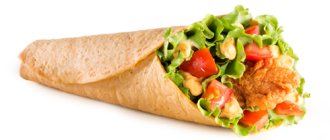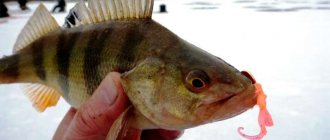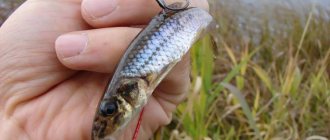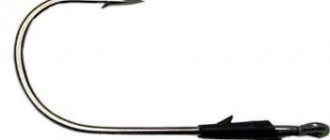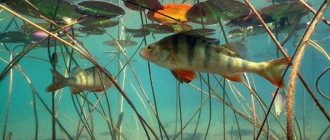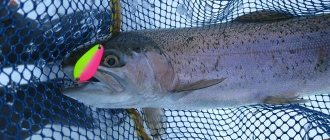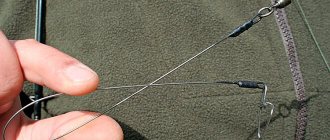Buy quality products at affordable prices in the best fishing online stores
. Give gifts to yourself and your loved ones!
we are in social networks
— subscribe to us on Facebook, Youtube, VKontakte and Instagram. Stay up to date with the latest site news.
Many spinning anglers note that silicone baits are best suited for catching perch. This is quite logical, since silicones have a very lively play and are suitable for any wiring, even for uniform wiring in the upper layers.
If we talk about specific silicones for fishing perch, then it responds best to twisters, vibrotails and baits in the form of crustaceans and shrimp. In this article we will find out which twisters are best suited for catching perch, which places are best to choose for such fishing and how to equip a spinning rod.
How to choose a twister for perch?
Attempts to catch nimble stripers on a twister bring positive emotions to many. But in order not to end up fishing without a catch, you need to choose the right bait.
Size and color
The optimal twister size for perch hunting is 3-5 cm. Perch will not always be able to swallow larger baits. Of course, the predator will also react to larger twisters, but the effectiveness will noticeably decrease. In addition, due to the large number of idle bites, the service life of the bait will be significantly reduced.
The color preferences of perch depend on the weather and water transparency. In cloudy weather, silicones with glitter are better; in bright sunshine, dark colors are preferable. Bright, flashy colors are effective in low light conditions in muddy water. The most catchy perch twisters have a combined white and red color with a clearly marked attack point.
Sinker shape and weight
The shape of the twister and the size of the sinkers are determined based on the fishing conditions and the type of wiring. Jig heads weighing from 5 to 25 grams are attached to twisters. Weight is determined depending on the strength of the current. Naturally, the heaviest jig heads weighing 25 grams should be attached to the twister in a very strong current.
A standard twister with a voluminous tail and a tubular body works great for perch. For slow retrieving, it is better to take models that have good buoyancy and windage.
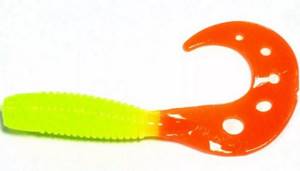
Twisters with one elongated or two tails are good for fishing on the surface and in the middle layers of water. When moving along the bottom, it is better to use the most “swively” twister, which can cause intense vibrations with minimal movement of the spinning rod.
What is a twister?
Among fishing enthusiasts, this name refers to a huge selection of baits made of silicone. They have a cylindrical elongated shape with a flat crescent-shaped tail at the end. In stores you can purchase modifications of twisters that have their own play during wiring. Several years ago, manufacturers of such baits used ordinary silicone material for production. Its use provided the products with high levels of elasticity and plasticity, which is why in the water element the baits sat securely on the hooks and behaved quickly, imitating the behavior of small fish. Predators attacked them, reacting exclusively to movements, but were not always detected.
Today, edible soft rubber has come to the fore in the production of artificial baits. Its creators add amino acids, flavored salts, and various attractants to silicone. Thus, baits appear that not only actively move, but also smell attractive, without raising doubts among predators.

“Edible” also has its own drawback - unreliable strength. It doesn't last long and quickly deteriorates. To bring it out of working condition, even the grip of a perch and asp, which do not have toothy mouths, is enough. On the other hand, such baits are much more catchy, which makes up for their disadvantage, besides, silicone is a consumable material, and nothing can be done about it.
Beginner fishermen confuse twisters with vibrotails. Both baits are made from silicone, but the second shape is more like a small fish. The main difference between a vibrotail and a twister is a more mobile tail. Thanks to this design, it plays better when wired.
To learn more:
How to catch perch with live bait: equipment and technique
What to choose, a twister or a vibrotail, each angler decides for himself. For pike hunting, the best option would be the second one; in water it is characterized by vibrations with low frequency and wide amplitude. Toothfish like such bait games more, since twisters create high-frequency vibrations.
They are also given an advantage in cases where long and targeted casts must be made from the shore. Their flight properties are much better than those of vibrotails. But if the fishing spots are covered with vegetation or snags, then it is advisable to choose a twister with a bait that catches less. In any case, every spinner should have new twisters and vibrotails that have been in “battles”.
Material
Silicone baits have proven themselves to be the best, including twisters made from edible rubber. Tasty amino acids and active flavors are added to its composition. This bait smells attractive and does not cause fear to the predator after he tries it.
Edible rubber is a relatively inexpensive and extremely catchy artificial bait for catching predators. And perch is no exception. It responds well to edible baits.
A huge variety of shapes, smells and shades of edible rubber allow you to choose the best option for specific fishing conditions. Perch prefers baits with a pronounced aroma of shrimp or fish.
Technologies and methods of twister installation
There are several successful ways to attach such a bait to create catchy fishing gear. The most popular are:
- installation based on a jig head;
- spaced twister rigs;
- non-snacking lure mounts;
- hinged mounting method.
The technique of spaced rigs is that the weight and the bait must be moved away from each other. In this case, the silicone gets more free space and allows the person with the rod to perform measured, slow retrieves.
When fishing in more difficult conditions, you need to choose equipment that does not get caught on obstacles. With this type of installation, you can confidently fish rocky areas of the bottom, snags, and reservoirs with abundant vegetation. It is better to attach the nozzle in tandem with an offset hook, then it can easily pass through difficult places. With such equipment, the tip is hidden in silicone, and with a successful bite it is released and dug into the predator’s mouth.
To properly attach a twister attachment to an offset hook, you need to select an offset of the required length. Then pierce the bait through the “mouth” from the head and bring the tip out into the “neck” area. The twister is pulled to the bend and smoothly brought to the eye. Having unrolled the hook, carefully fold the body of the bait and sharply pierce it. The sting is brought out at the top of the nozzle and “sunk” in silicone. At the last stage, the bait with a sharp offset hook is attached to a sinker of the required weight.
To learn more:
How to properly store maggots at home
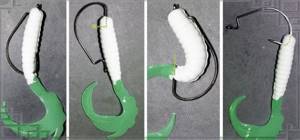
The most popular (even beginners and novice spinning anglers can handle it) way of mounting twisters is to mount them on a jig head - the bait is placed on a hook rigidly fixed in a weight. Twister jig heads come in the shape of a bullet, horseshoe, fish head, and boot. The most common are spherical. Such equipment is not difficult and provides the structure with the necessary rigidity of the connection.
The technology of hinged combination is that the twister is adapted to a single (you can use a double, triple - as you like) hook and attached to a weight called a “Cheburashka”. This fastening gives the bait a high level of freedom, allowing you to cast it to a maximum distance. The twister is attached to the weight with a clasp or winding ring. The disadvantage of this method is the possible overlap through the leash. In this case, the wiring will be less effective. To avoid unnecessary misfire, before inserting the twister, you need to slow down the slippery line by touching the spool with your fingers.
Secrets of perch hunting
- The best time to catch “striped” fish with a twister is dawn. It is at this time that there is a good opportunity to catch a trophy predator. In the evening, active biting is also possible.
- Catching perch at night is almost impossible.
- Perch prefers a schooling lifestyle. Therefore, you should not stop wiring if one predator chased the bait, tried edible silicone and did not attack it. Often, a hungrier bass can react almost immediately.
- Choosing a spoon for pike fishing in the fall
- Lucky John JIB Tail: detailed review
- What to catch chub with: the best baits and baits
- How to prepare dough for crucian carp
☸ Tackle
Installation of the twister can be carried out in four ways: on a rigid jig head, using free installation on a Cheburashka eared weight, using one or more retractable leashes and using an offset hook for non-snacking installation.
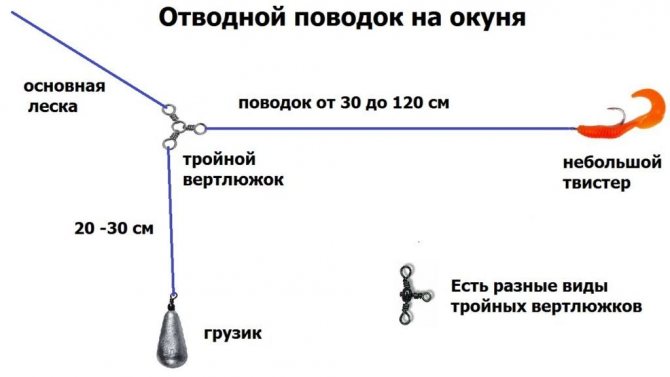
Depending on where the fishing will take place in still water or in the current, a sinker of the appropriate weight is selected: still water - from five to fifteen grams, in current - from fifteen to twenty-five grams. Before attaching the twister, it must be compared with the size of the hook; ideally, the tip of the hook should come out on the last waves of the bait and should not touch the tail of the twister, otherwise the level of its game will decrease significantly.
Active perch are caught on diverting leashes with bait. To carry out such an installation, you need to attach a sinker to the end of the main fishing line, then make two or three loops in increments of 10-15 centimeters and attach twenty-centimeter leashes equipped with hooks and baits to them.
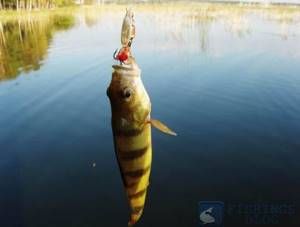
Colors of silicone lures
Date: January 23, 2021 | 194
The color of the silicone bait is one of the factors when choosing a specific rubber. One can argue for a long time about the importance of silicone color. Some people attach great importance to the choice of color, while others look almost dismissively at this parameter. The truth, as usual, is somewhere in the middle. Much in this matter depends on the fishing conditions, the breed, and the degree of activity of the fish. Well, since it is impossible to claim objectivity on such a controversial topic, in this article I will express my subjective opinion on various colors and features in their use.
The color of the edible and the color of ordinary silicone baits, which were at the height of fashion some 7-10 years ago, are in practice completely different palettes. Both the shape of rubber and their colors are evolving strongly and rapidly, multiplying and growing. For those interested in the topic of jigs and soft baits, these changes are very interesting.
It would seem that the color spectrum has been known for a very long time. But, at first, the manufacturers did not have enough desire or imagination. The usual set of colors for soft baits at that time was quite scarce. The favorites were: white, pearlescent, yellow, several shades of green, brown. Red and black also appeared, but somewhat less. Some colors had glitter, some without.
Here, for example, are the colors that were in use when I was just mastering jigs; I catch pike and perch with vibrating tails and twisters.
Then, two-color and three-color options appeared. For example, these.

Well, then it was time to eat. Yes, and the second wave of various ordinary silicone has arrived. And then it splashed from a rainbow fountain.

I see neither the point nor the possibility of describing each color. There are unique colors and shades from some manufacturers. Many colors are repeated. I will devote the rest of the article to analyzing a number of my favorite colors and the most popular ones, describing the conditions in which they work best for me.
Machine oil color . This is one of the most popular flowers among jigs, micro jigs and edibles. Brown, with a reddish or greenish tint. Sometimes sparkles are added to the material, shading the bait with one or another tint.

All forms of silicone baits are absolutely good in this color. Vibrating tails, twisters and medium-sized slugs in the color of machine oil are very good at catching pike perch. Various fishtails in this color are, for many anglers, including me, one of the best colors for perch.
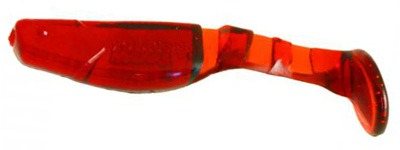
Various peaceful fish also react very positively to baits in this color.
I especially like micro-twisters, small vibrating tails, micro worms and slugs in this color. Machine oil has a greenish tint, which is almost the natural color for crayfish. So, for this form of edible, “motor oil” is very appropriate.
Basically I use this color from the moment the water becomes sufficiently clear until the end of the season.
Shades of brown . Machine oil borders very closely with a wider palette of shades of brown.
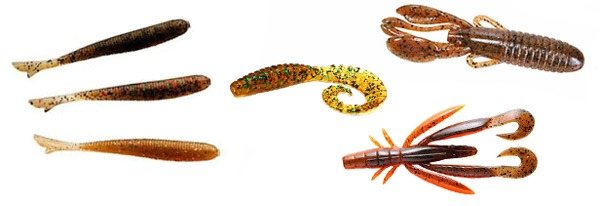
These are also very catchy and popular colors. I use them somewhat less frequently than “machine oil,” but they have also proven themselves to be extremely good. It’s not bad when the material is translucent, with the addition of multi-colored sparkles.
In particular, the edibles in the Ebimiso Sp color palette from Reins work well for me.
LOX color . The famous color LOX from Reins is one of the shades of purple. Despite all the strangeness and seeming unnaturalness of this color, it works brilliantly in a pond. Many copies have been broken regarding the best colors of silicone lures. But, in my opinion, and the opinion of many, some of the best are: “Loch” and “Machine oil”. I don’t even see the point in trying to put one of them at the top. Sometimes one works better, sometimes the other.

Also, Raines has another variation of this color “Pink Lox”, with a pinkish appearance. Didn't notice much difference.
Don't think that only Reins has such a killer color. Many companies use very similar colors in their palettes. There are analogues for Lucky John, Bait Breath, Crazy Fish, and many others. In general, I often go by color by eye rather than by code. There are many manufacturers. Each has its own codes and color names. Keeping all this in mind is more difficult than simply navigating by visual perception.
Speaking of the best colors of edibles. Either “machine oil”, “Lox”, ash-black, or “olive” - all are dark, all are similar in color to benthic organisms, crustaceans, spiders, leeches, crayfish, etc. And the hue, tint, greenish, purple - only emphasizes the similarity with the living prototype. This, as I see it, is the secret of the catchiness of these colors.
White color . White color, light, both on its own and in combinations, is a color close to natural, to natural. In vibrotails, slugs, fish - this is an imitation of light, silvery colored fry. In the case of twisters, worms - imitation of whitish earthworms, larvae, maggots.
So this color is also very popular. I caught a lot of pike in lakes and bays using a light jig with small and medium vibrating tails in this color.
Also, white silicone baits are clearly visible in muddy water. So, this color should be used in the spring, on rivers. In muddy water, not only pike and perch respond well to white bait, but also chub, asp, and ide.
Pearlescent color . Mother of pearl is also very similar to white in nature and application. But, there were cases when catching the same pike, when mother of pearl greatly exceeded the usual milky white in the number of bites. Apparently the glare from this color, especially when applied to active baits, vibrotails and twisters, as well as fish, is very appropriate.
Translucent, light . Various highly transparent colors are especially good in clear, clean water. Many benthic organisms, especially in the early stages of development, have not yet acquired a chitinous shell, and look translucent, with translucent organs. So, the success of silicone in such colors is quite understandable.

There are colors of this type with a greater or lesser degree of transparency, with or without colored sparkles in the structure.
Ash color . In my personal rating, the translucent black color with glitter is one of the favorites, on a level with “machine oil” and “sucker”. In fact, these three colors make up my personal TOP 3 when choosing the color of an edible.
This color is well represented in the Blue Gill color from Keitech and Kosadaka DS, and many manufacturers also have analogues.
Black color . Pure black, for some reason, is noticeably inferior to the previous color option. But small twisters and large thick leech worms in this color are very good.
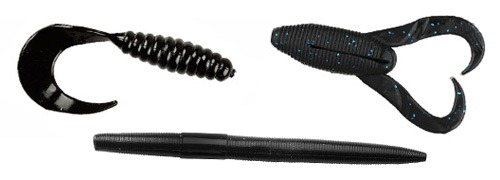
I would say that black lures especially make sense when it comes to contrast. A dark spot against the background of algae, against the background of a light sandy bottom, against the background of the sky - this provokes fish very well. So, I recommend placing absolutely black baits, first of all, in light, clear water.
Next, let's go through the main colors of the rainbow.
Red color . Despite all the similarity in color with bloodworms, worms, fish fins, despite all the stereotypes that a predator loves red because it is the color of blood, I have a frankly unimportant relationship with red silicone baits.
This food works well at shallow depths, up to 1-1.5 m, in clear water. Apparently, at greater depths, red is seen as dark gray, and there is no longer any color resemblance to the prey. So, I can recommend this color for shallow fishing.
There are red phosphorescent baits that accumulate light. They can be successfully used for deep-sea jigging. However, at depth nothing remains of their redness - only a glow...
Pink color . Pink lures are very popular for coastal fishing in the sea (rock fishing), as well as for trout fishing in clear lakes and streams.

Sometimes this color of bait works very well for pike perch and pike perch. Despite all the glamor, these colors worked much better for me than red.
Pink is an excellent provocateur color, a representative of bright colors. Accordingly, in addition to clear water, this coloring can be successfully used in muddy water and on a passive predator that needs to be stirred up and shocked. In particular, such a bright unnatural color can help with this.
Orange. Carrot . The carrot sometimes, very infrequently, but it works and shoots. I'm not a big fan of this colorway. But, as second-tier baits, I have carrot-colored silicones and from time to time they help out.
Yellow. Lemon . In the era when pike perch and pike were caught using classic jigs and vibrating tails, yellow was one of the most lethal and catchy colors. And even now, if you fish with an ordinary jig using the old classics, then it remains so.
However, this color does not appear so often in modern edible silicone baits. And, it seems to me, yellow, for some reason, turns out to be one of the colors that has most lost its position and popularity. I don’t know, maybe it’s not so for someone. But this is exactly the picture I get. If I fish with active baits, vibrating tails, sometimes with twisters, then the yellow color is in use. When it comes to other forms of edibles, its place is very insignificant. A strange phenomenon.
Salad color . About the same story as with yellow. This color works very actively in vibrotails and twisters for active pike and pike perch, especially in not very clear water.
In the format of worms, slugs, crayfish, somehow these colors didn’t work for me.
Dull green . Green with a haze of white and yellow. This was the color of the first vibrotails on which I started catching pike, mastering jig fishing. And now, when it comes to catching catfish, I also take baits of this color with me and use them.
Edibles in these colors, in my opinion, are somewhat more interesting than just yellow or bright green. But, again, this is just my subjective opinion.
Green color . Shades of green are a very good and popular color. Of course, in heavily overgrown places, near algae, this color is lost. But, on a relatively clean bottom, on rocks, on sand, on clay, among snags, it is quite possible. In some cases, dark green colors are in no way inferior to other dark classics.

I would especially note the olive tint of the baits. And also, green colors, additionally saturated with sparkles.
Shades of blue . To be honest, I still haven’t warmed up to the blue colors of silicone... But when jigging pike perch at extremely great depths, it makes sense to try such colors.
Purple color . Well, in fact, purple and its shades are the closest “relatives” of the already mentioned color “LOX”. So it works well!
Combined coloring pages . Many silicone baits have multi-colored colors designed to emphasize realism, to almost photographically recreate the living food object that this or that bait imitates. Of course, these colors are most appropriate when imitating a fish. Less commonly, for shrimp and crustaceans.
Contrasting color combinations . Also, very often there are combined colors based on two or three colors. For example, this is a contrasting coloring of the back and abdomen of a silicone fish, vibrotail, slug.
A red spot, or other contrasting spot in the head or tail of the bait is a good technique. And here the point is not so much in the redness of the spot, but in its contrast. It turns out that the attack point for the fish is highlighted in color. It is for this purpose that many fish imitations have living three-dimensional eyes.
Presence of sparkles . It cannot be said unequivocally that the presence of glitter increases catchability. But the presence of sparkles of one color or another in the material, of course, enriches the palette.
Phosphorescent colors . There are baits in which the material has light accumulating properties. As a rule, these are white, yellow, green or red baits. At great depths, in the dark, they glow.
And now, a little physics. Different parts of the light spectrum, different colors, behave differently in water with increasing depth. This is due to the refraction of a ray of light on the surface of the water. And the thicker the layer of water, the greater the depth at the observation point, the fewer visible colors remain.
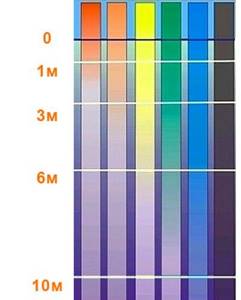
The red one disappears first. So, red baits lose all meaning deeper than 1.5-2m. And in muddy, dark water, even higher, about 1 m. Further, at the level of 3 meters, orange disappears. At 4-5m - yellow. Green works up to 6-7m. Blue and purple also work at depths that are almost limiting for jigs, up to 10m and a little more.
So, in addition to the recommendations for choosing silicone colors discussed in the material, you can correlate your choice with the depths at which you plan to fish.
Share with your friends:
Categories: Edible · Tags: Lures, Edible, Color
